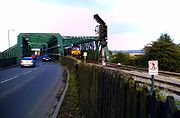
Keadby Bridge
Encyclopedia
Keadby Bridge, more formally known as the King George V Bridge, crosses the River Trent
near Althorpe
and Keadby
in Lincolnshire
.
This Scherzer rolling lift bridge carries both road and rail traffic across the River Trent. It was built between 1912 and 1916 by the Great Central Railway
to replace a previous swing bridge built by the South Yorkshire Railway
in 1866. It carries a double track rail line on the southern side, and the two-lane, single carriageway A18 road on the north side.
 Its 163ft electricity powered bascule (lifting span) was one of the first of its type in Britain and when built, was the largest in Europe. Designed by James Ball and C A Rowlandson and built by contractors Sir William Arrol & Co.
Its 163ft electricity powered bascule (lifting span) was one of the first of its type in Britain and when built, was the largest in Europe. Designed by James Ball and C A Rowlandson and built by contractors Sir William Arrol & Co.
it has three main spans and two approach spans. The eastern main span was the one that lifted. The Scherzer bascule rolled and rotated on counterbalance. It was electrically powered, originally by a large storage battery fed by petrol-driven generators housed in the engine room beneath the east approach span. This was later modified to mains electricity.
The bridge has not been lifted since 1956. The bridge was widened and the headroom increased in 1960 and the bascule was fixed in position.
River Trent
The River Trent is one of the major rivers of England. Its source is in Staffordshire on the southern edge of Biddulph Moor. It flows through the Midlands until it joins the River Ouse at Trent Falls to form the Humber Estuary, which empties into the North Sea below Hull and Immingham.The Trent...
near Althorpe
Althorpe
Althorpe is a small village lying on the A18 four miles west of Scunthorpe, in North Lincolnshire, England. To the west of Althorpe is the town of Crowle.-Geography:...
and Keadby
Keadby
Keadby is a small village lying just off the A18, west of Scunthorpe, in North Lincolnshire, England. It lies on the West bank of the River Trent. It is pronounced "Kidby"....
in Lincolnshire
Lincolnshire
Lincolnshire is a county in the east of England. It borders Norfolk to the south east, Cambridgeshire to the south, Rutland to the south west, Leicestershire and Nottinghamshire to the west, South Yorkshire to the north west, and the East Riding of Yorkshire to the north. It also borders...
.
History
The King George V bridge was opened by King George V, the chairmen of the railway company and Lindsey County Council on 21 May 1916This Scherzer rolling lift bridge carries both road and rail traffic across the River Trent. It was built between 1912 and 1916 by the Great Central Railway
Great Central Railway
The Great Central Railway was a railway company in England which came into being when the Manchester, Sheffield and Lincolnshire Railway changed its name in 1897 in anticipation of the opening in 1899 of its London Extension . On 1 January 1923, it was grouped into the London and North Eastern...
to replace a previous swing bridge built by the South Yorkshire Railway
South Yorkshire Railway
The South Yorkshire Railway was a railway company which was based in the south of the former West Riding of Yorkshire, England. Its first section of line opened on 10 November 1849 between Swinton Junction and Doncaster...
in 1866. It carries a double track rail line on the southern side, and the two-lane, single carriageway A18 road on the north side.

Sir William Arrol & Co.
Sir William Arrol & Co. was a leading Scottish civil engineering business founded by William Arrol and based in Glasgow. It built some of the most famous bridges in the United Kingdom including the Forth Bridge and Tower Bridge in London.-Early history:...
it has three main spans and two approach spans. The eastern main span was the one that lifted. The Scherzer bascule rolled and rotated on counterbalance. It was electrically powered, originally by a large storage battery fed by petrol-driven generators housed in the engine room beneath the east approach span. This was later modified to mains electricity.
The bridge has not been lifted since 1956. The bridge was widened and the headroom increased in 1960 and the bascule was fixed in position.

